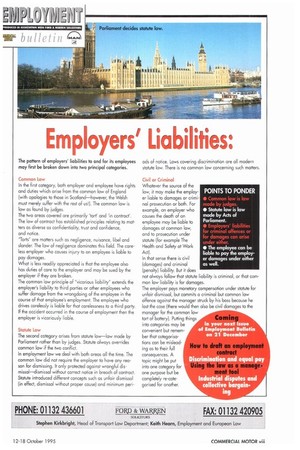Employers' Liabilities:
Page 62

If you've noticed an error in this article please click here to report it so we can fix it.
The pattern of employers' liabilities to and for its employees may first be broken down into two principal categories.
Common Law In the first category, both employer and employee have rights and duties which arise from the common law of England (with apologies to those in Scotland—however, the Welsh must merely suffer with the rest of us!). The common law is low as found by judges.
The two areas covered are primarily 'tort' and 'in contract'. The law of contract has established principles relating to matters as diverse as confidentiality, trust and confidence, and notice.
"Torts" are matters such as negligence, nuisance, libel and slander. The law of negligence dominates this field. The careless employer who causes injury to an employee is liable to pay damages.
What is less readily appreciated is that the employee also has duties of care to the employer and may be sued by the employer if they are broken.
The common law principle of "vicarious liability" extends the employer's liability to third parties or other employees who suffer damage from the wrongdoing of the employee in the course of that employee's employment. The employee who drives carelessly is liable for that carelessness to a third party. If the accident occurred in the course of employment then the employer is vicariously liable.
Statute Law
The second category arises from statute law—law made by Parliament rather than by judges. Statute always overrides common law if the two conflict.
In employment law we deal with both areas all the time. The common law did not require the employer to have any reason for dismissing. It only protected against wrongful dismissal—dismissal without correct notice in breach of contract. Statute introduced different concepts such as unfair dismissal (in effect, dismissal without proper cause) and minimum peri ods of notice. Laws covering discrimination are all modern statute law. There is no common law concerning such matters.
Civil or Criminal Whatever the source of the law, it may make the employer liable to damages or criminal prosecution or both. For example, an employer who causes the death of an employee may be liable to damages at common law, and to prosecution under statute (for example The Health and Safety at Work Act).
In that sense there is civil (damages) and criminal (penalty) liability. But it does not always follow that statute liability is criminal, or that common law liability is for damages.




















































































































